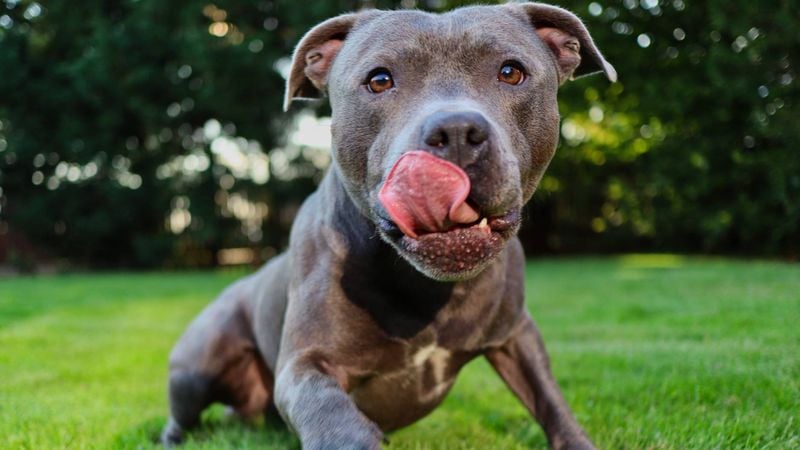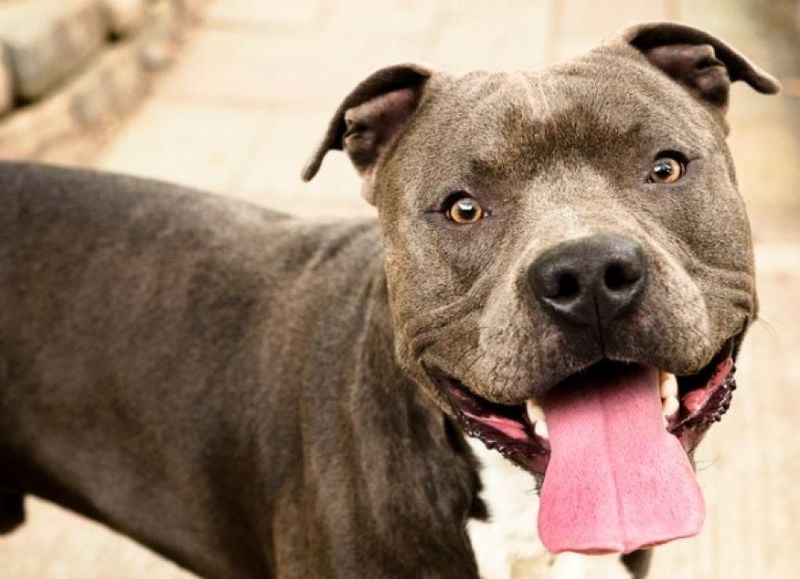16 Reasons Pit Bulls Aren’t the Villains You’ve Been Told They Are
Pit bulls have gotten a bad rap in recent years. These dogs have been portrayed as dangerous and aggressive in news stories and movies. But there’s a huge gap between the scary image and the reality of these misunderstood canines.
Let’s look at why pit bulls deserve a second chance in the court of public opinion.
1. “Pit Bull” Isn’t Actually a Breed
The term “pit bull” actually refers to several different breeds including American Pit Bull Terriers, American Staffordshire Terriers, and Staffordshire Bull Terriers. Many dogs labeled as pit bulls in shelters aren’t even these breeds at all!
DNA testing often reveals mixed-breed dogs with completely different ancestry than expected. This confusion makes statistics about “pit bull attacks” highly unreliable since the dogs involved might not even be pit bulls.
Understanding this distinction matters because it shows how we’ve lumped diverse dogs under one scary label, painting them all with the same brush unfairly.
2. Media Bias Creates Unfair Fear
News outlets often report dog attacks with dramatically different language depending on the breed involved. When a pit bull-type dog is involved, headlines scream danger, while similar incidents with other breeds might be buried or reported sympathetically.
Research from the National Canine Research Council found that pit bull incidents receive up to 5 times more media coverage than attacks involving other dogs. This reporting bias shapes public perception, making people believe pit bulls are uniquely dangerous.
The next time you see a scary headline, remember that media sensationalism sells stories but doesn’t always reflect reality.
3. America’s Former Sweetheart Dogs
Before the 1980s, pit bulls were America’s darlings! They starred as mascots like RCA’s Nipper and Pete the Pup from The Little Rascals. These dogs were considered ideal family pets for their loyalty and good nature with children.
During World War I, a pit bull named Sergeant Stubby became the most decorated war dog, saving his regiment from gas attacks. Even Helen Keller had a pit bull as her companion.
This positive reputation lasted for decades until media portrayals shifted dramatically in the 1980s, transforming public perception from beloved companion to feared aggressor almost overnight.
4. The Owner Factor Makes a Huge Difference
Unfortunately, pit bulls often attract owners who want tough-looking dogs for the wrong reasons. Some irresponsible people deliberately train these dogs to be aggressive or use them for illegal fighting, creating the very problems that feed negative stereotypes.
Studies show that owner behavior – not breed – is the strongest predictor of dog aggression. Dogs that aren’t properly socialized, are kept chained, or suffer abuse are more likely to develop behavior problems regardless of breed.
Many pit bull issues trace back to human choices, not inherent dog nature. With responsible ownership, these dogs thrive as gentle companions.
5. Loyalty That Knows No Bounds
Pit bulls form incredibly strong bonds with their families. Their devotion has saved countless lives in emergencies – like Weela, who rescued 30 people during California floods, or Patty, who woke her family during a house fire.
These dogs typically score high on temperament tests for their steadfast nature. The American Temperament Test Society reports that pit bulls consistently pass their standardized evaluations at rates similar to or better than popular family breeds.
Their desire to please their humans makes them especially responsive to positive training methods, creating deep connections that pit bull owners describe as unlike any other dog relationship.
6. Aggression Myths Don’t Match Reality
Scientific studies consistently find pit bulls aren’t inherently more aggressive than other dogs. The American Veterinary Medical Association analyzed multiple studies and concluded no breed is disproportionately dangerous.
Temperament testing by major organizations reveals pit bulls often score better than many popular family breeds! The American Temperament Test Society reports pit bulls pass their standardized test at a rate of 87.4%, beating golden retrievers (85.6%).
Small dogs actually bite more frequently, but those incidents rarely make headlines because they cause less damage. The difference isn’t temperament but simply size and strength.
7. High Energy Often Misunderstood
Pit bulls are athletic, energetic dogs with playful personalities. Their enthusiasm and bouncy nature can sometimes be misinterpreted as aggression by people unfamiliar with dog body language.
That excited wiggle when greeting you? Pure joy, not aggression. Their muscular build and strong play drive make them seem more intense, but they’re just being typical active dogs who need proper exercise outlets.
Many behaviorists recommend sports like agility or weight pulling for pit bulls. These activities channel their natural energy constructively while strengthening the bond between dog and owner.
8. People-Pleasing Personalities
Pit bulls thrive on human approval and connection. This eagerness to please makes them highly trainable and responsive to positive reinforcement techniques.
Their desire for human approval explains why they excel in obedience, therapy work, and service roles. Many pit bulls can learn complex commands quickly when training is approached with consistency and positive methods.
This people-oriented nature contradicts the stubborn, uncontrollable stereotype. Most pit bull owners describe their dogs as velcro companions who constantly seek attention and affirmation from their favorite humans.
9. Breed-Specific Laws Cause More Harm Than Good
Breed-specific legislation (BSL) bans or restricts certain dogs based solely on appearance, not behavior. These laws have failed to reduce dog bites in communities where they’ve been implemented.
Cities like Cincinnati have repealed their pit bull bans after finding them ineffective and expensive to enforce. Meanwhile, places focusing on owner responsibility laws see better results in reducing dog incidents.
BSL separates families from beloved pets and euthanizes dogs that have never shown aggression. Organizations from the CDC to the American Bar Association oppose these laws because they’re ineffective and unfair.
10. The Identification Problem
Visual breed identification is shockingly unreliable. Studies show even animal professionals misidentify breeds regularly, with error rates up to 75% when compared with DNA testing.
Many dogs labeled as “pit bulls” in bite statistics or shelter records are actually mixed breeds with no pit bull ancestry at all. This identification problem makes statistics about pit bull behavior fundamentally flawed.
A University of Florida study found that shelter workers frequently disagreed with each other when trying to identify pit bulls, demonstrating how subjective these labels are. This misidentification directly contributes to inflated statistics about pit bull incidents.
11. Shelter Discrimination Creates Heartbreak
Pit bulls face the highest euthanasia rates in shelters nationwide. In some facilities, they account for up to 40% of dogs taken in but 80% of those euthanized.
Housing discrimination forces many loving owners to surrender their pets when moving. Breed restrictions in apartments, HOAs, and insurance policies create impossible situations for families who must choose between housing and keeping their beloved dog.
Many shelters now run special programs specifically for pit bulls, offering reduced adoption fees and positive marketing to help these dogs find homes. Organizations like Animal Farm Foundation work to combat discrimination through education and advocacy.
12. Victims of Human Cruelty
Pit bulls suffer tremendously from dogfighting and abuse. Their strength and loyalty make them targets for people with cruel intentions who exploit these traits for profit or status.
The infamous Michael Vick case revealed how these dogs are tortured to create aggression. Yet remarkably, many dogs rescued from fighting rings show extraordinary resilience and rehabilitation potential.
Organizations specializing in pit bull rescue report that with proper care and training, former fighting dogs can become loving pets. The story of Vick’s dogs, many of whom became therapy animals, demonstrates their capacity to overcome horrific treatment.
13. Born Helpers: Service and Therapy Stars
Pit bulls make outstanding therapy and service dogs because of their intelligence, strength, and people-focused nature. Organizations like Pit Bulls for Patriots train these dogs to support veterans with PTSD.
Their stable temperaments and desire to please make them ideal hospital and nursing home visitors. Dogs like Therapy Pit Bull Lily bring comfort to cancer patients, while others help children improve reading skills through library programs.
As mobility service dogs, their strength helps pull wheelchairs and provide balance support. Their success in these roles directly contradicts the dangerous stereotype, showing their natural inclination to help and comfort humans.
14. Pop Culture Portrayal Problems
Movies and TV shows frequently cast pit bulls as menacing symbols of danger. This portrayal reinforces negative stereotypes while ignoring the reality of these dogs.
Contrast this with earlier decades when Petey from The Little Rascals (a pit bull) represented childhood companionship. This shift in representation has directly influenced public perception.
When positive pit bull stories appear in media – like the rescued fighting dogs who became therapy animals – public attitudes begin to change. More balanced representation helps people see beyond stereotypes to the real dogs underneath the hype.
15. Strength Doesn’t Equal Aggression
Pit bulls are naturally muscular and strong – that’s just their physical build. Unfortunately, people often mistake physical capability for behavioral tendency, assuming strength means aggression.
Many powerful dog breeds like Rottweilers and German Shepherds face similar misconceptions. The reality is that a dog’s physical attributes don’t determine its temperament or likelihood to bite.
Responsible owners channel this strength positively through activities like weight pulling competitions or agility. These showcase the dogs’ athletic abilities while building confidence and focus, proving strength can be a wonderful attribute when properly directed.
16. Every Dog is an Individual
Judging any dog based solely on breed ignores the complex factors that shape behavior. Genetics, training, socialization, and individual personality all interact to create each unique dog.
Professional trainers and behaviorists emphasize evaluating dogs as individuals rather than making breed-based assumptions. Modern animal behavior science supports this approach, recognizing the limitations of breed as a predictor of temperament.
Meet a pit bull with an open mind, and you’ll likely find the stereotypes don’t match the wiggly, affectionate dog in front of you. This individualized approach benefits all dogs and leads to fairer treatment based on actual behavior.






















